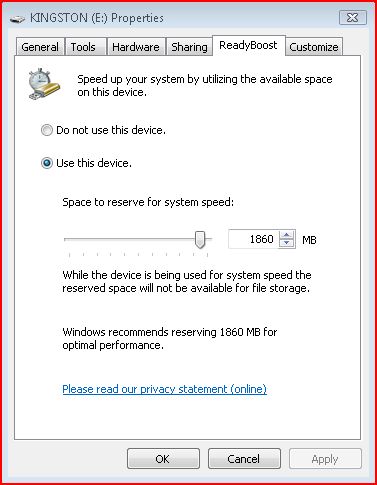The Great Vista/Mac Showdown: ReadyBoost stands alone


ReadyBoost builds on the features of the Superfetch memory management technology discussed last time, acting as a faster cache. Superfetch manages recently used applications and data to cache frequently needed data and, in contrast to earlier versions of Windows, pre-caches based on the user's habits and time of day or day of the week.
As Grant Gibson, who maintains an authoritative list of ReadyBoost-compatible devices, explains, you need to buy the fastest flash memory available to get the benefits of this technology. As you can see in the screen grab at the right, ReadyBoost can allocate up to about 90 percent of available flash capacity to caching data. Once you configure a ReadyBoost device, Vista remembers the device and settings, preserving the capacity for ReadyBoost use.
USB flash and compact flash cards don't deliver the kind of data throughput that a hard drive does, but the access times can be so low that cached data can be moved to active memory faster than from the drive. For example, the ThinkPad X60 I'm using has a 7,200-rpm 100GB drive provides access times of 12ms compared to that of the 2GB Kingston DataTravelerII USB flash drive I am using, which has a 1ms access time.
The hard drive can move data at up to 150MBps. The Kingston flash has throughput of 11MBps, less than a tenth the drive's throughput. Flash memory's write speed, which runs in the 7MBps range, becomes a real issue when writing large files to the ReadyBoost cache. You'll likely see improved performance with smaller files and applications that don't load the cache, such as a photo editing tool will, which might keep more than a Gigabyte in memory so that you can quickly undo an edit.
Someone using a high-end system with two Gigabytes of RAM probably won't notice the difference ReadyBoost makes, since there's plenty of memory available for Superfetch to use.
But if you've got a laptop or desktop with 512MB of RAM and use the typical range of productivity applications rather than memory-intensive imaging and analytics apps, adding ReadyBoost memory is going to make the computer perform better. For $28.95, for example, you can plug in almost 2GB of cache to a system.
So, for the low-end market in this comparison, Vista's ReadyBoost provides a performance edge that is simply unavailable in the Mac market today. This round goes to Vista.